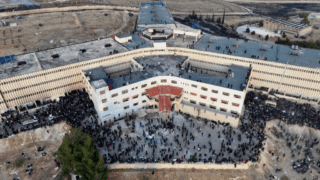
Syria’s Assad flees Damascus as opposition forces take control of capital
The Syrian government collapsed early on 8 December in a stunning end to the Assad family’s 50-year rule, as opposition forces entered Damascus following a lightning offensive that captured major cities across the country in just ten days, according to AP, Aljazeera, and Syrian opposition sources.
This marks a major setback for Russia, whose military intervention over the past 10 years sustained Bashar al-Assad’s regime in exchange for access to the Tartus port and Khmeimim airbase for operations in the Middle East and Africa. Assad’s fall marks a seismic moment for the Middle East, dealing a massive blow not only to Russia, but also Iran, which has also been using Syria for operations in the region.
Syrian state television aired a statement by opposition forces announcing President Bashar al-Assad had been overthrown and all prisoners of his regime freed.
“The city of Damascus has been liberated,” rebels declared in their first broadcast on state TV, according to Aljazeera, adding: “The tyrant Bashar al-Assad has been toppled. All the prisoners have been released from the prison of Damascus. We wish all our fighters and citizens to preserve and maintain the property of the state of Syria. Long live Syria.”
Two senior army officers told Reuters that Assad flew out of Damascus early on Sunday, 6 December, for an unknown destination. Rami Abdurrahman of the Syrian Observatory for Human Rights confirmed to AP that Assad took a flight from Damascus. Iranian state television also reported Assad had left the capital, citing Qatar’s Al Jazeera network.
The Syrian government collapsed early on 8 December in a stunning end to the Assad family’s 50-year rule, as opposition forces entered Damascus following a lightning offensive that captured major cities across the country in just ten days, according to AP, Aljazeera, and Syrian opposition sources.
This marks a major setback for Russia, whose military intervention over the past 10 years sustained Bashar al-Assad’s regime in exchange for access to the Tartus port and Khmeimim airbase for operations in the Middle East and Africa. Assad’s fall marks a seismic moment for the Middle East, dealing a massive blow not only to Russia, but also Iran, which has also been using Syria for operations in the region.
Syrian state television aired a statement by opposition forces announcing President Bashar al-Assad had been overthrown and all prisoners of his regime freed.
“The city of Damascus has been liberated,” rebels declared in their first broadcast on state TV, according to Aljazeera, adding: “The tyrant Bashar al-Assad has been toppled. All the prisoners have been released from the prison of Damascus. We wish all our fighters and citizens to preserve and maintain the property of the state of Syria. Long live Syria.”
Two senior army officers told Reuters that Assad flew out of Damascus early on Sunday, 6 December, for an unknown destination. Rami Abdurrahman of the Syrian Observatory for Human Rights confirmed to AP that Assad took a flight from Damascus. Iranian state television also reported Assad had left the capital, citing Qatar’s Al Jazeera network.
The Syrian government collapsed early on 8 December in a stunning end to the Assad family’s 50-year rule, as opposition forces entered Damascus following a lightning offensive that captured major cities across the country in just ten days, according to AP, Aljazeera, and Syrian opposition sources.
This marks a major setback for Russia, whose military intervention over the past 10 years sustained Bashar al-Assad’s regime in exchange for access to the Tartus port and Khmeimim airbase for operations in the Middle East and Africa. Assad’s fall marks a seismic moment for the Middle East, dealing a massive blow not only to Russia, but also Iran, which has also been using Syria for operations in the region.
Syrian state television aired a statement by opposition forces announcing President Bashar al-Assad had been overthrown and all prisoners of his regime freed.
“The city of Damascus has been liberated,” rebels declared in their first broadcast on state TV, according to Aljazeera, adding: “The tyrant Bashar al-Assad has been toppled. All the prisoners have been released from the prison of Damascus. We wish all our fighters and citizens to preserve and maintain the property of the state of Syria. Long live Syria.”
Two senior army officers told Reuters that Assad flew out of Damascus early on Sunday, 6 December, for an unknown destination. Rami Abdurrahman of the Syrian Observatory for Human Rights confirmed to AP that Assad took a flight from Damascus. Iranian state television also reported Assad had left the capital, citing Qatar’s Al Jazeera network.
The Syrian government collapsed early on 8 December in a stunning end to the Assad family’s 50-year rule, as opposition forces entered Damascus following a lightning offensive that captured major cities across the country in just ten days, according to AP, Aljazeera, and Syrian opposition sources.
This marks a major setback for Russia, whose military intervention over the past 10 years sustained Bashar al-Assad’s regime in exchange for access to the Tartus port and Khmeimim airbase for operations in the Middle East and Africa. Assad’s fall marks a seismic moment for the Middle East, dealing a massive blow not only to Russia, but also Iran, which has also been using Syria for operations in the region.
Syrian state television aired a statement by opposition forces announcing President Bashar al-Assad had been overthrown and all prisoners of his regime freed.
“The city of Damascus has been liberated,” rebels declared in their first broadcast on state TV, according to Aljazeera, adding: “The tyrant Bashar al-Assad has been toppled. All the prisoners have been released from the prison of Damascus. We wish all our fighters and citizens to preserve and maintain the property of the state of Syria. Long live Syria.”
Two senior army officers told Reuters that Assad flew out of Damascus early on Sunday, 6 December, for an unknown destination. Rami Abdurrahman of the Syrian Observatory for Human Rights confirmed to AP that Assad took a flight from Damascus. Iranian state television also reported Assad had left the capital, citing Qatar’s Al Jazeera network.
With Russia fully invested in its ongoing invasion of Ukraine, Moscow would be unlikely to provide more than symbolic support to Assad.
Ukrainian military analyst Tatarigami argues that the swift fall of Assad’s regime undermines the “realities-on-the-ground” approach to negotiations in the Russo-Ukrainian war, stating:
“One of the biggest lessons from Syria is that, just a month ago, almost no one could have predicted the Assad regime would fall today. The “realities on the ground” crowd would have denied such a possibility. A reminder of why people in Ukraine fight rather than surrender.”
Regional response
The UN’s special envoy for Syria, Geir Pedersen, called for urgent talks in Geneva to ensure an “orderly political transition,” according to AP. Eight key countries including Saudi Arabia, Russia, Egypt, Türkiye, and Iran met on the sidelines of the Doha Summit to discuss the situation.
AP reported that Lebanon closed all land border crossings with Syria except one linking Beirut with Damascus, while Jordan shut its border crossing. According to Iraqi government spokesperson Bassem al-Awadi, about 2,000 Syrian army soldiers crossed into Iraq seeking refuge.
Menawhile, Israeli tanks reportedly crossed into Syria for the first time since 1974, following Israel’s announcement to bolster its military presence in response to the rebel offensive. The move aims to prevent Syrian forces or civilians from approaching Israeli positions, according to Maariv newspaper, Aljazeera reported.
Timeline of Syria’s war
- March 2011: Peaceful protests erupt in Damascus and Deraa, met with government crackdown, sparkling a war between the ruling regime and the opposition.
- July 2012: Opposition forces seize large parts of Aleppo.
- August 2013: Chemical weapons attack in Eastern Ghouta kills hundreds.
- June 2014: ISIL declares caliphate across Syria and Iraq.
- September 2015: Russia begins direct military intervention supporting Assad, subsequently taking control of the most of Syria.
- April 2017: US launches missile strikes against Syrian government targets.
- 27 November 2024: Opposition launches offensive from Idlib.
- 29 November 2024: Rebels capture Aleppo.
- 5 December 2024: Opposition takes Hama.
- 7 December 2024: Rebels seize Homs.
- 8 December 2024: Opposition enters Damascus, Assad flees.
Related:
















